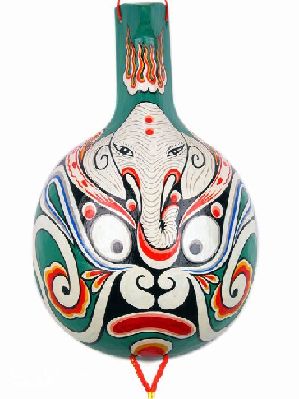Paper-cuts

Paper-cuts refer to handicrafts made by cutting paper with scissors to form different patterns and pasting them on walls, windows, doors and ceilings. With their long history, paper-cuts, which originated in China, have been very popular among the ordinary people of China.
Chinese paper-cuts are rich in content. The auspicious designs symbolize good luck and the avoidance of evil. The child, lotus and bottle gourd designs suggest a family with a large number of children and grandchildren. Domestic birds, livestock, fruit, fish and worms are also familiar objects depicted by Chinese farmers. There are some special paper-cuts of traditional design used as patterns for embroidering clothes, shoes, hats, pillows, bed curtains and door curtains.
Sun Erlin, the paper-cut artist from the Inner Mongolian Autonomous Region, and Liao Yunwu, the paper-cut artist from Fujian Province, were invited to the Olympic Village to display the live show of paper cutting. Born into a family of paper-cuts artists, Sun Erlin inherits her family’s cutting style and her works are tinted with the nomadic culture in the grassland. Liao Yunwu is known for cutting paper portraits at a high speed and cutting paper with his eyes blinded.
Painted clay figurines

The craft of making painted clay-figurines has long been a popular folk art in China. There are different schools of clay-figurine making in terms of styles, including Fengxiang clay figurine in Shaanxi Province, Clay Figurine Zhang in Tianjin, Huishan clay figurine in Wuxi, Jiangsu Province, and Gaomi clay figurine in Shandong Province.
Hu Xinmin, the leading successor of Fengxiang figurines from Shaanxi Province, and Zhang Hongyue, the fifth generation of ‘Clay Figurines Zhang’ from Tianjin, are at the Olympic Village to demonstrate their skills on the spot.
The Fengxiang figurines are made of local clay, which was mixed with pulp and painted after it was shaped. The colors of Fengxiang figurines are extremely bright, and with intensive contrasts. With a black outline, they are primarily scarlet, green and yellow. The figurines have a wide-range of subjects, including facial makeup, folklore, historical stories, rural life and others. Their bold and short shapes are widely exaggerated.
‘Clay Figurines Zhang’ was a kind of school of art in northern China. It was initiated by Zhang Mingshan in the late Qing Dynasty (1644-1911). His clay figurines were very vivid and expressive, and Zhang and his figurines were soon well known in the surrounding area. Zhang not only inherited the legacy of traditional skills but also incorporated skills from other art forms such as painting, opera singing and Chinese folk wood engravings. People liked his clay figurines very much and gave him the nickname of Clay Figurine Zhang.
Facial masks

Zhao Yongqi, the Lianpu (facial make-up in Peking Opera) artist from Beijing, is invited to the Olympic Village to demonstrate his face-painting skill.
Lianpu is a unique way to portrait characters, which is native to China. It refers to the color patterns painted on the faces of opera performers. Specific types of facial make-up are exploited in Peking Opera to symbolize the personalities, characteristics, and fates of the roles. Usually, red faces have positive meanings, symbolizing brave, faithful, and wise men. Another positive color is purple, which signifies wisdom and bravery.
In addition to Zhao Yongqi, Zhang Xing, the painter of ladle masks from Baoji, Shaanxi Province, is also drawing attention with his painting skill. From ancient times, the ladle masks, usually made of willow woods, were used to exorcise evils and pray for auspice and safety. Along with other traditional Chinese arts like shadow plays, embroidery, clay sculpture and kite-making, the ladle masking became windows to showcase the folk arts that have become rarities.